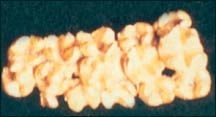
Gold sculpture which depicts 14 lotus flowers
by KAREL ROBERTS RATNAWEERA - Sunday Observer Feb 15 2004
|
|
At a recent meeting in the auditorium of the National Museum, Colombo, Professor Chandra Wickremagamage drew attention to a 10th century AD inscription ascribed to King Mahinda IV pertaining to the original Temple of the Sacred Tooth Relic of the Buddha. The inscription deals with the management of lands offered to the temple which must have been located adjacent to the rock inscription, Prof. Wickremagamage said. Two other similar rock inscriptions at Matale are also attributed to Mahinda IV.
The stone slabs are polished with a variety of polish found in India in the 3rd century BC and known as the Mauryan polish. Sri Lankan artists however, had not used this kind of polish before the 10th century AD, or it could be that they had in fact used this Mauryan polish in some of their work that may have got lost. This special polish, Prof. Wickremagamage said, is not mentioned even in ancient literature.
|
|
Scientific analysis show that this polish had made an important contribution to the works of art during the Asokan period not only in the famous Asokan pillars but even in the depiction of yakshayas in the folk art tradition of India.
What Prof. Wickremagamage described as a very exciting find at the Jetawana excavations is a gold sculpture which depicts 14 lotus flowers which, however, cannot be seen clearly unless enlarged 150 times their original size.
The professor said that to produce this sort of artefact, the goldsmith must have used some sort of magnifying glass to enable him to carve the gold sculpture. Molten gold would have been poured into a mould which would have been originally made of clay which, when dried, would have drained out any wax which would have been poured into the clay mould. Prof. Wickremagamage said that he did not know of any other similar artefact in Sri Lanka or elsewhere. It is a unique find which reveals the very important technical aspects of such fine work. However, he did say that it was not certain whether the particular gold artefact was Sri Lankan or foreign. It was found by the archaeological team of UNESCO at Jetawanarama.
|
|
A food heater which was found by Prof. Wickremagamage during the Abhayagiri excavations between 1981-1987 might well be the precursor of what hotels use to keep food hot at buffets. Made of burnt clay, it reveals the high quality of life in the Anuradhapura period.
The professor touched on Sigiriya which he said is unique because of the hydraulic engineering technicalities that had been used to beautify the rock fortress with no less than three waterways, not to mention the system that took water from ground level to construct fountains on the rock's summit.
Prof. Wickremagamage said there are still 'very exciting' discoveries to be made at the royal rock.
Acknowledgements:
(A) Courtesy Archaeological Department.
Pic by Nimal Gunewardene.
(B) Courtesy Jetawana Project of the Cultural Triangle
(C) Courtesy Abhayagiri Project of the Cultural Triangle.